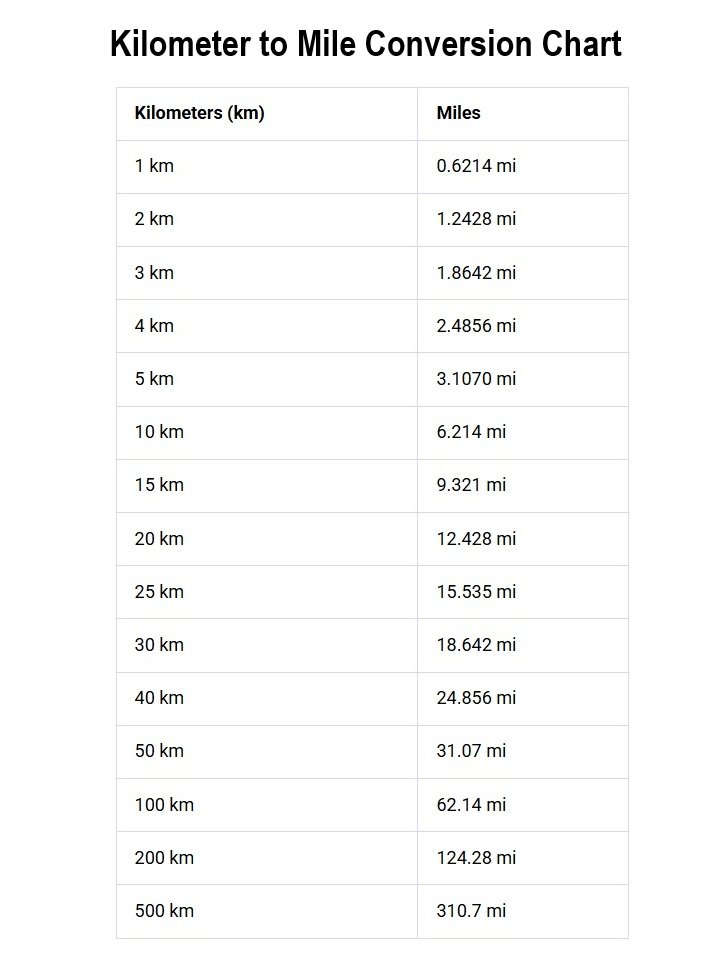Kilometer to Mile Conversion
Kilometer to Mile Converter
Conversion Result
| Kilometers | Miles |
| 1 km | 0.621 mi |
| 5 km | 3.107 mi |
| 10 km | 6.214 mi |
| 21.1 km | 13.11 mi (Half Marathon) |
| 42.2 km | 26.22 mi (Full Marathon) |
| 100 km | 62.137 mi |
What is a Kilometer?
A kilometer (km) is a unit used to measure long distances, like how far your school is from home or the length of a running track or how is one city from another. It’s part of the metric system, which is used worldwide (except in a few countries like the USA). In USA miles is the most common terms used to measure distances. One kilometer is a little more than half a mile (about 0.62 miles).What is a Mile?
A mile is a way to measure distance, mostly used in the United States and a few other countries. It’s longer than a kilometer. If you think about walking, one mile is about how far you’d walk in 15 to 20 minutes at a normal pace. People often use miles to describe how far it is to drive somewhere, from point A to point B.
A mile is equal to about 1.61 kilometers or 1,609 meters. So, it is just another way to describe how far something is, just like kilometers but a little bigger!
Kilometers to Miles Conversion Formula
Miles = Kilometers × 0.621373
How many miles is 1 kilometer?
Example: 1 kilometer × 0.621373 = 0.621373 or 0.6214 miles
Which is longer, a mile or a kilometer?
A mile is longer than a kilometer. If you walk one kilometer and then walk one mile, you’ll notice the mile takes more time. In fact, one mile is about 1.61 kilometers.
Why are miles and kilometers different?
Miles and kilometers are different because they come from two different measurement systems. Miles are used in countries like the United States, while kilometers are used in most other countries including Asia and UK/Europe.

Where to use Our Calculator
When it comes to transportation and logistics, converting kilometers to miles helps companies plan routes and estimate travel times, especially when deliveries cross country borders where different units are used. Truck drivers, logistics managers, and freight companies rely on these conversions to keep routes clear and costs accurate for both local and international shipments.
Aviation: In aviation, pilots and air traffic controllers often need to convert kilometers to miles when preparing flight plans or talking with airports in countries that use different units. This makes sure everyone understands distances the same way, which keeps flights safe and on schedule, whether they’re crossing states or oceans.
Automotive Industry: In the automotive industry, people convert kilometers to miles to compare car mileage and fuel efficiency between different countries. For example, European cars often list fuel economy in kilometers per liter while American cars use miles per gallon. So, buyers and sellers need these conversions to understand exactly how far a vehicle can go.
Sports & Athletics: In sports and athletics, especially for marathons and races, converting kilometers to miles helps organizers set up race lengths that meet international standards. Athletes who train or compete in different countries use it to compare training distances so they stay on track with their goals, no matter where they run.
Education: In education, teachers and students use kilometer to mile conversions in geography, math, and science lessons to solve real-world problems. It’s a handy way for kids to learn about measurement systems and how they change across countries, which builds practical math skills they can use outside the classroom too.
Maritime & Shipping: In maritime and shipping, ship captains and route planners sometimes need to convert kilometers to nautical miles and regular miles when plotting courses. Since different maps and countries use different units, converting these distances helps ships travel safely and arrive on time, whether they’re crossing lakes, seas, or open ocean.
Other Calculators
Grams to Teaspoon, Fl oz to cups, oz to ml, Simple Interest Calculator, Compound Interest Calculator